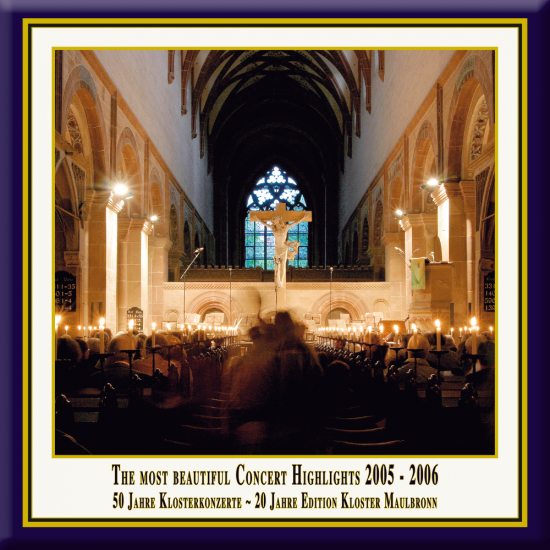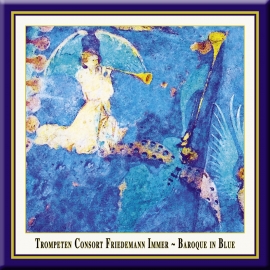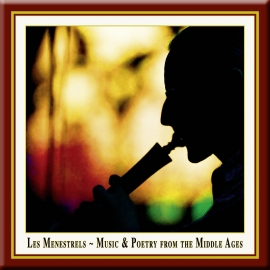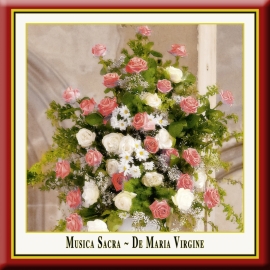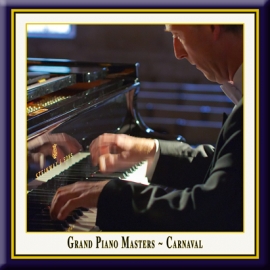Vol. 08: The most beautiful Concert Highlights 2005-2006
The most beautiful Concert Highlights
from Maulbronn Monastery 2005-2006
The 50th Anniversary of the Maulbronn Monastery Concerts
Anniversary Series, Vol. 8
Highlights from:
George Frideric Handel:
Messiah, HWV 56
(September 24 & 25, 2005)
The concert "Baroque in Blue · A Crossover between Early Music & Jazz" (June 3, 2005):
Ferdinand Donninger: Musical idea of a sea battle
Michel-Richard Delalande: Concert de Trompettes
Girolamo Fantini: Trumpet Sonata No. 4 "Detta del Saracinelli"
The concert "Hosanna in excelsis · Music & Poetry in the Middle Ages" (June 5, 2005):
Nikolaus Apel Codex: Psalm 115: "Nicht uns, o Herr, nicht uns..."
c. 1300: Nova laude, terra, plaude... · 14th Century: Chaldivaldi
Alfonso el Sabio: Praeludio: "Santa Maria amar..."
Excerpts from the concert "Musica Sacra · De Maria Virgine" (May 18, 2006):
Mikhail Glinka: Kheruvimskaya (Cherubim's Song) · Anton Bruckner: Ave Maria
George Frideric Handel: Dignare from the Te Deum in D Major, HWV 283 "Dettingen"
Johann Sebastian Bach: Jesu, meine Freude · Dietrich Buxtehude: Cantate Domino canticum novum
Highlights from the piano recital "Grand Piano Masters · Carnaval" (May 25, 2006):
Wolfgang Amadeus Mozart: Piano Sonata No. 12 in F Major, K. 332
Franz Schubert: Piano Sonata No. 16 in A Minor, Op. 42, D. 845
Robert Schumann: Excerpts from Carnaval, Op. 9 "Little Scenes on Four Notes"
Live recordings from the German UNESCO World Heritage Site Maulbronn Monastery
HD Recording · DDD · Duration: c. 103 Minutes
Digital Album · 35 Tracks · incl. Digital Booklet


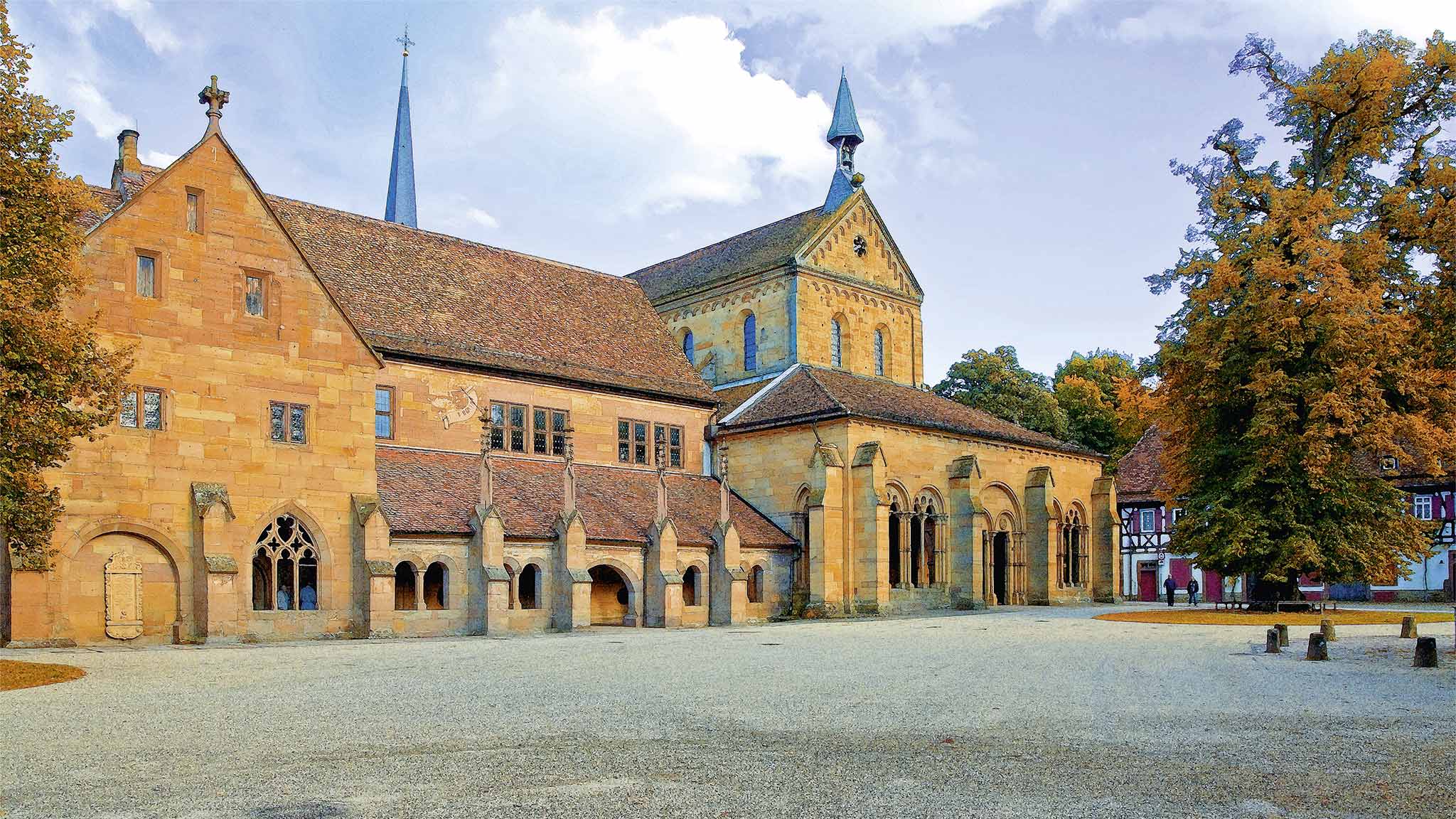
W
e have been documenting for 20 years the concerts at the UNESCO World Heritage Maulbronn Monastery. The concerts supply the ideal conditions for our aspirations. It is, above all, the atmosphere of the romantic, candle-lit arches, the magic of the monastery in its unadulterated sublime presence and tranquillity that impresses itself upon the performers and audience of these concerts. Renowned soloists and ensembles from the international arena repeatedly welcome the opportunity to appear here - enjoying the unparalleled acoustic and architectural beauty of this World Heritage Site, providing exquisite performances of secular and sacred music, documented by us in our Maulbronn Monastery Edition.
Josef-Stefan Kindler & Andreas Otto Grimminger, K&K Verlagsanstalt
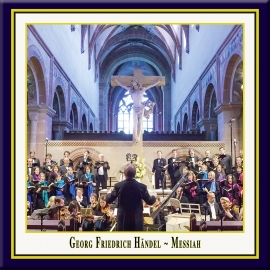
Messiah by George Frideric Handel (1685-1759)
A vital aspect of Jürgen Budday's interpretation of George Frideric Handel's The Messiah, apart from matters of performance practice, is his focus on the work's dynamic conception. Dynamics are notated in the autograph manuscript, but Handel further annotated the Dublin score to mark the ripieno passages. By adding shifts in ensemble strength to the alternation of piano and forte, Handel evokes an ample measure of contrast and colour. Handel's dynamic indications in The Messiah go beyond the usual forte, piano and pianissimo to include mezzo piano and un poco piano, markings by which he intended an even finer differentiation. One would do well, when preparing a performance, to observe the ripieno indications in the Dublin score, as they are for the most part essential to Handel's dynamic conception. Examples in point include the arias Comfort ye (No. 2) and Ev'ry valley shall be exalted (No. 3); the choruses And the glory, the glory of the Lord (No. 4) and His yoke is easy, His burthen is light! (No. 18); as well as the beginning of the Hallelujah chorus (CD II, No. 16).
The Maulbronn interpretation takes this dynamic conception seriously and clearly differentiates solo and ripieno sections in the numbers just mentioned. This inevitably gives rise to novel and more subtle auditory impressions, for which the beginning of the Hallelujah chorus provides a clear example. Elsewhere, Handel's senza ripieno indications appear to have been motivated more by consideration of the technical inadequacies of his ripienisti, and therefore were not observed in the Maulbronn performance. The libretto and the music, each in itself and together as a whole, form a providential unity. The libretto, ascribed to Charles Jennens, is no mere compilation of Bible quotations, and Jennens made various changes to the wording of the selected text passages. In the course of successive performances, Handel composed variants of some of the arias to fit the immediate occasion or circumstances. For the Maulbronn performance, those variants were chosen that Handel himself is said to have preferred.
This live recording of Handel's The Messiah is part of a cycle of oratorios and masses, performed in the basilica of Maulbronn Abbey under the direction of Jürgen Budday. The series combines authentically performed oratorios and masses with the optimal acoustics and atmosphere of this unique monastic church. This ideal location demands the transparency of playing and the interpretive unveiling of the rhetoric intimations of the composition, which is especially aided by the historically informed performance. The music is exclusively performed on reconstructed historical instruments, which are tuned to the pitch customary in the composer's lifetimes (this performance is tuned in a' = 415 Hz).
The concert: "Baroque in Blue · A Crossover between Early Music & Jazz"
"Amazing, these blues notes; for me, a subject that never ceases to fascinate, those small, dirty inconsistencies that give Swing its grooviness time and time again.. Recently, I thought that it would really sound very interesting if these hallmarks of jazz were actually played on historical instruments. What really surprised me, however, was discovering - in the course of comparing the baroque compositions of old maters - that these stylistic tools of the musical revolution of the 20th century were in fact quite usual back in Bach's day or at the court of the French King. I wish you a most pleasant evening with this concert." (Josef-Stefan Kindler)
Established in 1988 by Friedemann Immer, the Friedemann Immer Trumpet Consort dedicates itself to the music played by the trumpet ensembles of the Baroque age The Consort's programmes exude the wonderfully resplendent sound typical of the music of that time. All the members of the ensemble are specialists in old music and, accordingly, the trumpeters play baroque trumpets that have no valves. In doing so, they are treading in the footsteps of a profession that was highly regarded at a time when powdered wigs and buckled shoes were de rigueur. The trumpet players employed at the courts and in the towns, who provided the necessary musical accompaniment at coronations, weddings, tournaments and other festive occasions, banded together in guilds of their own that had extremely strict rules and regulations. The ensembles were made up of three to eight trumpeters and timpanists, supplemented by strings, woodwinds and continuo instruments. In its "normal" line-up, the Friedemann Immer Trumpet Consort is accompanied by timpani and organ - so that the magnificent sound of the trumpet stays firmly in the forefront of things. In some works, the organ takes over the string part - an arrangement that is totally in keeping with the practice of the times. The ensemble's repertoire encompasses all of Baroque music. The line-up is unusually large for a standing ensemble of Baroque trumpets and allows a lot of different options in the way of variations. So the Consort not only performs works for one to six trumpets with accompaniment, it also presents - along with outstanding song soloists - cantatas and arias with all the original parts being performed. In many a project, strings are also brought in. And, as what can be done musically and sound-wise on the Baroque trumpet differs quite considerably from anything that its present-day "daughter" with all its valves can do, the ensemble has also turned to interpreting modern works on the Baroque trumpet - and they are probably totally alone in this. The repertoire of the Trumpet Consort not only includes original works by Benjamin Britten, for instance, but quite a large range of jazz pieces as well. Since its formation, the ensemble has been giving concerts both at home and abroad. They have played at many different festivals, examples being the Arolsen Baroque Festival, the Styriarte in Graz and the Kokutopia Festival in Tokyo as well as the International Trumpet Guild Conference and the Historic Brass Symposium in the USA.
The concert: "Hosanna in excelsis · Music & Poetry in the Middle Ages"
"Play and pleasure are necessary to the sustenance of human life. However, all services useful to human sustenance must be regarded as permissible. Therefore, the services of menestrels, which are intended to provide cheer, are not a forbidden thing, provided that they are not in a state of sin, and they exercise moderation in their playing - namely that they use no hateful words and do not begin playing during work or at forbidden times. And those who support the menestrels are not committing sin! Rather, they deal justly when they give them for their services that which is their due." ("As stated above..." from: Summa II, quaestio 168, Article 3, Thomas Aquinas, c.1225-1274)
Texts and music from the spiritual world of the European Middle Ages form the subject matter of this programme, which the Les Menestrels Ensemble has put together specially for this performance held in the monastery church at Maulbronn. One is astonished by the abundant variety of language and subject matter on offer here. Yet perhaps even more astonishing is the widespread, cross-border dissemination of a body of religious and cultural thought that flourished outside church walls. In today's monotonous popular culture, shaped as it is by the dogma that what sells is what matters, cultural and human values no longer enjoy pride of place. Linguistic standardisation is pursued aggressively, and dialects, expressions and cultural resonances travel beyond regional borders in only the rarest of cases. In the song as cultivated in the Middle Ages, however, we find a linguistically multifaceted culture; one that is, in this sense, truly more European. Modern media have wrought little improvement. On the contrary, inquisitorial surveillance has found its match in the uniformity-enforcing filter of a profit-oriented business management "culture." The Church may well have imposed strict guidelines, as Klaus Walter describes in the notes below, but at least the themes that were the focus of artistic creation were those by which human beings are moved, and wit and subtlety challenged the human intellect. (Josef-Stefan Kindler)
The concert: "Musica Sacra · De Maria Virgine"
The Moscow State Academic Choir is one of the oldest and most famous of Russian choruses. The choir was founded in 1956 by the venerated conductor Vladislav Sokolov, a winner of the Glinka State Prize of the Russian Federation, and a People's Artist of the USSR. Already in 1957, the chorus took first prize at the 6th World Youth and Students Festival in Russia, and has maintained a high profile ever since. The chorus has toured regularly not only in Russia, but also in Western Europe and Asia. A great number of choral works by Russian composers were given their debut by the Moscow State Academic Choir, including Prokofiev's Ivan the Terrible and Kabalevsky's Requiem. Within its broad repertory is a large number of Russian spiritual and patriotic works, the great choral scenes from various Russian operas, and choral versions of Russian and other folk melodies. In 1988, the baton of the Moscow State Choir was passed to Andrey Kozhevnikov, who had been Sokolov's assistant since 1970. Kozhevnikov, a People's Artist of the Russian Federation, and winner of several international competitions, was trained at the Moscow State Choir School and then at the Moscow Conservatory - studying with S.Kazansky and A.Sveshnikov. Under Kozhevnikov's leadership, the Moscow State Choir has resurrected a number of early Russian works, including Degtyarev's patriotic oratorio, Minin and Pozharsky - the first such Russian work, written on the eve of the Patriotic War of 1812; it is among the works featured here at the Classical Archives.
The Piano Sonata No. 12 in F Major, K. 332 by Wolfgang Amadeus Mozart (1756-1791)
The Piano Sonata No. 12 by Wolfgang Amadeus Mozart was written at the same time as the Piano Sonata, K. 330, and Piano Sonata, K. 331 ("Alla turca"), Mozart numbering them as a set from one to three. They were once believed to have been written in the late 1770s in Paris, but it is now thought more likely that they date from 1783, by which time Mozart had moved to Vienna. Some believe that Mozart wrote this and the other sonatas during a summer 1783 visit to Salzburg made for the purpose of introducing his wife, Constanze to his father, Leopold. All three sonatas were published in Vienna in 1784... [From Wikipedia, the free encyclopedia]
The Piano Sonata No. 16 in A Minor, Op. 42, D. 845 by Franz Schubert (1797-1828)
The Piano Sonata No. 16 by Franz Schubert is a sonata for solo piano, composed in May 1825. The first movement was featured in the 2016 film "The Age of Shadows". The first movement is in sonata form though with ambiguity over the material in the development and the beginning of the recapitulation. The second movement is in C major (relative key to A minor) variation form, with somewhat frequent forays into the parallel minor, C minor. The third movement is a scherzo in compound ternary form, where the main scherzo is essentially in sonata form. The main scherzo opens in A minor and soon switches to the second theme in C major without a transition. The development goes through F minor, A-flat major and A-flat minor, finally arriving on an imperfect cadence in A minor. After the development comes the opening theme in A minor, soon followed by the second theme in A major (also in which the main scherzo ends). The calmer and slower trio section is in F major, the submediant major to A minor (also the subdominant of the relative key to A minor). No extra coda is present after the recapitulated main scherzo. The fourth movement, in A minor, begins with a melancholic but light melody. This movement is in sonata rondo form with foreshortened recapitulation. The secondary subject in the exposition goes from E minor to E major, while that in the recapitulation goes from A minor to A major. This movement finally closes in A minor... [From Wikipedia, the free encyclopedia]
Carnaval for Piano, Op. 9 "Little Scenes on Four Notes", by Robert Schumann (1810-1856)
Carnaval, Op. 9, is a work by Robert Schumann for piano solo, written in 1834-1835, and subtitled "Scènes mignonnes sur quatre notes" (Little Scenes on Four Notes). It consists of 21 short pieces representing masked revelers at Carnival, a festival before Lent. Schumann gives musical expression to himself, his friends and colleagues, and characters from improvised Italian comedy (commedia dell'arte). He dedicated the work to the violinist Karol Lipinski. Carnaval had its origin in a set of variations on a "Sehnsuchtswalzer" by Franz Schubert, whose music Schumann had only discovered in 1827. The catalyst for writing the variations may have been a work for piano and orchestra by Schumann's close friend Ludwig Schuncke, a set of variations on the same Schubert theme. Schumann felt that Schuncke's heroic treatment was an inappropriate reflection of the tender nature of the Schubert piece, so he set out to approach his variations in a more intimate way, and worked on them in 1833 and 1834. The work was never completed, however, and Schuncke died in December 1834, but Schumann did re-use the opening 24 measures for the opening of Carnaval. Pianist Andreas Boyde has since reconstructed the original set of variations from Schumann's manuscript (published by Hofmeister Musikverlag), premiered this reconstruction in New York and recorded it for Athene Records... [From Wikipedia, the free encyclopedia]
P
ublishing Authentic Classical Concerts entails for us capturing and recording outstanding performances and concerts for posterity. The performers, audience, opus and room enter into an intimate dialogue that in its form and expression, its atmosphere, is unique and unrepeatable. It is our aim, the philosophy of our house, to enable the listener to acutely experience every facet of this symbiosis, the intensity of the performance, so we record the concerts in direct 2-Track Stereo digital HD. The results are unparalleled interpretations of musical and literary works, simply - audiophile snapshots of permanent value. Flourishing culture, enthralling the audience and last but not least also you the listener, are the values we endeavor to document in our editions and series.
The concerts at the UNESCO World Heritage Maulbronn Monastery supply the ideal conditions for our aspirations. It is, above all, the atmosphere of the romantic, candle-lit arches, the magic of the monastery in its unadulterated sublime presence and tranquillity that impresses itself upon the performers and audience of these concerts. Renowned soloists and ensembles from the international arena repeatedly welcome the opportunity to appear here - enjoying the unparalleled acoustic and architectural beauty of this World Heritage Site, providing exquisite performances of secular and sacred music, documented by us in our Maulbronn Monastery Edition.
The concert grand piano is incontestably the king of instruments. We could now wax lyrical about its incomparable dynamics and go into its ability to go from the tenderest of sounds in a soft minor key to the magnificent power of a fortissimo, or I could rhapsodise about its impressive size and elegance. But what makes this instrument really fascinating is its individuality, since each one is unique in itself - created by a master. A concert grand has a life all of its own that a virtuoso can really "get into" and hence bring the work of the composer to life. In our Grand Piano Masters Series, we get into the character and soul of the concert grand piano and experience, during the performance itself, the dialogue between the instrument, the virtuoso and the performance space.
Andreas Otto Grimminger & Josef-Stefan Kindler, K&K Verlagsanstalt
George Frideric Handel (1685-1759):
Messiah
The English Oratorio HWV 56,
performed according to the traditions of the time
by the Maulbronn Chamber Choir
and the Hanoverian Court Orchestra,
conducted by Jürgen Budday
on September 24 & 25, 2005
Words by Charles Jennens
1. Part I: Sinfonia (Overture) [3:11]
for Orchesta
2. Part I: Comfort ye my people, saith your God [3:10]
Accompagnato of Tenor · Soloist: Mark Le Brocq (Tenor)
3. Part I: And the glory of the Lord shall be revealed [2:27]
Chorus
4. Part I: Thus saith the Lord, the Lord of Hosts [1:24]
Accompagnato of Bass · Soloist: Christopher Purves (Bass)
5. Part I: And He shall purify the sons of Levi [2:13]
Chorus
6. Part I: For unto us a child is born [3:44]
Chorus
7. Part I: And lo, the angel of the Lord came upon them -
And the angel said unto them: Fear not [0:53]
Accompagnato & Recitative of Soprano · Soloist: Miriam Allan (Soprano)
8. Part I: And suddenly there was with the angel [0:16]
Accompagnato of Soprano · Soloist: Miriam Allan (Soprano)
9. Part I: Glory to God in the highest [1:51]
Chorus
10. Part I: He shall feed His flock like a shepherd [5:38]
Duet of Soprano & Alto
Soloists: Miriam Allan (Soprano) & Michael Chance (Countertenor)
11. Part II: The Lord gave the word [1:08]
Chorus
12. Part II: Why do the nations so furiously rage together [2:40]
Aria of Bass · Soloist: Christopher Purves (Bass)
13. Part II: Let us break their bonds asunder [1:37]
Chorus
14. Part II: Hallelujah! [3:33]
Chorus
15. Part III: O Death, where is thy sting - But thanks be to God [3:21]
Duet of Alto & Tenor and Chorus
Soloists: Michael Chance (Countertenor) & Mark Le Brocq (Tenor)
16. Part III: Amen [3:18]
Chorus
Excerpts from the concert:
Baroque in Blue
A Crossover between Early Music & Jazz
performed by the Friedemann Immer Trumpet Consort:
Friedemann Immer, Klaus H. Osterloh, Jaroslav Roucek & Thibaud Robinne (Baroque Trumpets)
Frithjof Koch (Baroque Timpani) · Matthias Nagel (Organ)
on June 3, 2005
Ferdinand Donninger (1716-1781):
17. Musikalische Vorstellung einer Seeschlacht [4:13]
Musical idea of a sea battle (Excerpts)
for 4 Trumpets, Timpani and Organ
Michel-Richard Delalande (1657-1726):
18. Concert de Trompettes [7:53]
for 4 Trumpets, Timpani and Organ
Girolamo Fantini (1600-1675):
19. Trumpet Sonata No. 4, "Detta del Saracinelli" [4:10]
for Trumpet and Organ
Highlights from the concert:
Hosanna in excelsis
Music & Poetry in the Middle Ages
performed by the Ensemble Les Menestrels:
Birgit Kurtz (Soprano) · Florian Mayr (Countertenor) · Kurt Kempf (Tenor)
Erich Klug (Bass) · Klaus Walter (Lute) · Michel Walter (Cornetto)
Eva Brunner (Descant Strings) · Gebhard Chalupsky (Tubing Sheet Instruments)
on June 5, 2005
Nikolaus Apel Codex (c. 1500):
20. Psalm 115: "Nicht uns, o Herr, nicht uns..." [3:32]
Anonymous (c. 1300):
21. Nova laude, terra, plaude... [2:01]
Benedicamustropus, Benedictinerinnenkloster Konstanz
Alfonso el Sabio (reg. 1252-1284):
22. Praeludio: "Santa Maria amar..." [2:43]
from: "Cantigas de Santa Maria"
Anonymous (14th Century):
23. Chaldivaldi [3:34]
Tanz aus einer Vysehrader Handschrift
Excerpts from the concert:
Musica Sacra · De Maria Virgine
Russian-Orthodox and European Sacred Choral Music,
performed by the Moscow State Academic Choir,
conducted by Andrej Koshewnikow
on May 18, 2006
Mikhail Glinka (1804-1857):
24. Kheruvimskaya (Cherubim's Song) [5:36]
for Chorus in C Major
Anton Bruckner (1824-1896):
25. Ave Maria [4:52]
Motet for Choir in F Major, WAB 6
George Frideric Handel (1685-1759):
26. Dignare [2:13]
from: Te Deum for Choir in D Major, HWV 283 "Dettingen"
Johann Sebastian Bach (1685-1750):
27. Jesu, meine Freude [1:52]
The 1st Movement of the Motet in E Minor for Choir, BWV 227
Dietrich Buxtehude (c.1637-1707):
28. Cantate Domino canticum novum [1:07]
A part of the 1st Section from the Motet for Choir in G Major, BuxWV 12
Highlights from the piano recital:
Grand Piano Masters · Carnaval
performed by Rolf Plagge (Piano)
on May 25, 2006
Wolfgang Amadeus Mozart (1756-1791):
Piano Sonata No. 12 in F Major, K. 332
29. II. Adagio [4:26]
Franz Schubert (1797-1828):
Piano Sonata No. 16 in A Minor, Op. 42, D. 845
30. IV. Rondo. Allegro vivace [4:59]
Robert Schumann (1810-1856):
Carnaval for Piano, Op. 9 "Little Scenes on Four Notes"
31. No. 1, Preambule [2:24]
32. No. 3, Arlequin - No. 4, Valse noble [2:53]
33. No. 9, Papillons [0:46]
34. No. 16, Valse allemande - No. 17, Intermezzo: Paganini [2:14]
35. No. 18, Aveu [1:22]
Sound & Recording Engineer: Andreas Otto Grimminger
Production & Mastering: Andreas Otto Grimminger & Josef-Stefan Kindler
Photography: Josef-Stefan Kindler
Artwork & Coverdesign: Josef-Stefan Kindler

